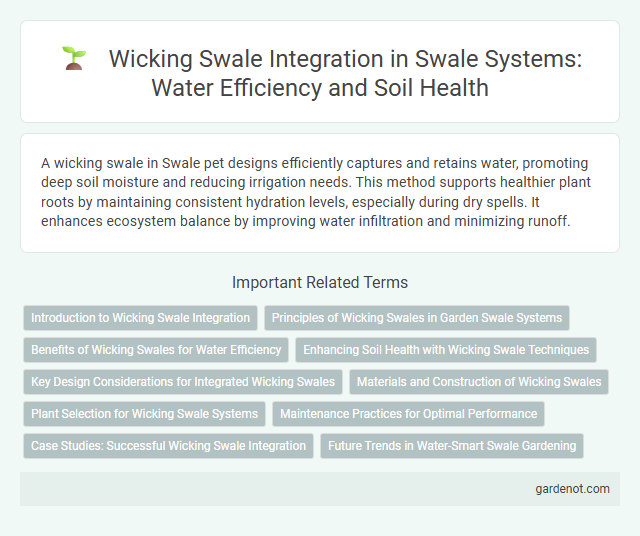A wicking swale in Swale pet designs efficiently captures and retains water, promoting deep soil moisture and reducing irrigation needs. This method supports healthier plant roots by maintaining consistent hydration levels, especially during dry spells. It enhances ecosystem balance by improving water infiltration and minimizing runoff.
Introduction to Wicking Swale Integration
Wicking swale integration enhances traditional swales by incorporating a wicking layer that improves moisture retention and plant water availability. This system uses capillary action to draw water from the water table or stored runoff, promoting sustained soil hydration for vegetation. Wicking swales optimize stormwater management by combining infiltration, water conservation, and enhanced plant growth in urban and landscape settings.
Principles of Wicking Swales in Garden Swale Systems
Wicking swales utilize capillary action to draw water from the swale's moisture-rich soil upward into the root zones of adjacent plants, optimizing water availability during dry periods. These systems combine the earth-contouring benefits of traditional swales with an integrated wicking layer made of materials like sand or porous soil to enhance water retention and distribution. Incorporating wicking swales in garden swale systems improves drought resilience, promotes deep root growth, and supports sustainable irrigation practices.
Benefits of Wicking Swales for Water Efficiency
Wicking swales enhance water efficiency by promoting consistent soil moisture through capillary action, reducing the need for frequent irrigation. They support plant health by ensuring roots receive adequate water even during dry periods, minimizing water waste. These swales also contribute to groundwater recharge and mitigate runoff, improving overall landscape sustainability.
Enhancing Soil Health with Wicking Swale Techniques
Wicking swales improve soil health by promoting efficient water retention and distribution, reducing erosion and nutrient loss. These engineered landscape features integrate subsurface moisture control, supporting deep root growth and enhancing microbial activity. By maintaining consistent soil moisture levels, wicking swales foster nutrient cycling and increase overall soil fertility.
Key Design Considerations for Integrated Wicking Swales
Key design considerations for integrated wicking swales include soil permeability, ensuring the media supports adequate water retention and capillary action for efficient water distribution. Incorporation of appropriate vegetation enhances evapotranspiration and stabilizes the swale structure. Precise grading and overflow mechanisms prevent stagnation and facilitate optimal water infiltration.
Materials and Construction of Wicking Swales
Wicking swales are constructed using layers of permeable materials such as gravel or coarse sand to facilitate water infiltration and retention, topped with nutrient-rich soil to support plant growth. Incorporating organic matter like compost enhances moisture retention and promotes microbial activity, improving overall soil health. The design typically includes a slight slope and berm to guide water flow and maximize absorption while preventing erosion.
Plant Selection for Wicking Swale Systems
Selecting plants for wicking swale systems requires prioritizing species with high drought tolerance and deep root structures to optimize water uptake and soil stability. Native grasses, sedges, and succulents such as Carex, Juncus, and Agave thrive in fluctuating moisture conditions typical of wicking swales, enhancing both filtration and infiltration rates. Integrating nitrogen-fixing legumes like Lupinus or Indigofera improves soil fertility while supporting the overall ecosystem balance within the wicking swale environment.
Maintenance Practices for Optimal Performance
Wicking swales require regular inspection to ensure proper water infiltration and prevent clogging of the soil medium. Maintenance practices include removing debris, controlling invasive vegetation, and monitoring soil moisture levels to maintain optimal hydration for plant roots. Periodic replenishment of organic matter enhances soil structure, promoting efficient wicking and sustained stormwater management.
Case Studies: Successful Wicking Swale Integration
Wicking swale systems have demonstrated significant success in urban stormwater management, notably in Portland, Oregon, where integrating native plants with a wicking liner reduced runoff by 40%. Case studies from Melbourne, Australia, highlight that wicking swales improved soil moisture retention, leading to a 25% increase in vegetation survival during dry periods. These projects underscore the effectiveness of wicking swales in enhancing groundwater recharge and promoting sustainable landscaping in varying climate conditions.
Future Trends in Water-Smart Swale Gardening
Wicking swales are emerging as a cutting-edge solution in water-smart gardening by enhancing soil moisture retention and reducing irrigation needs through capillary action. Future trends point to integrating sensor technology and automated water management systems, optimizing water use efficiency in urban landscaping and agriculture. Innovative materials and design improvements are expected to boost the sustainability and adaptability of wicking swales in diverse climatic conditions.
Wicking swale Infographic

 gardenot.com
gardenot.com